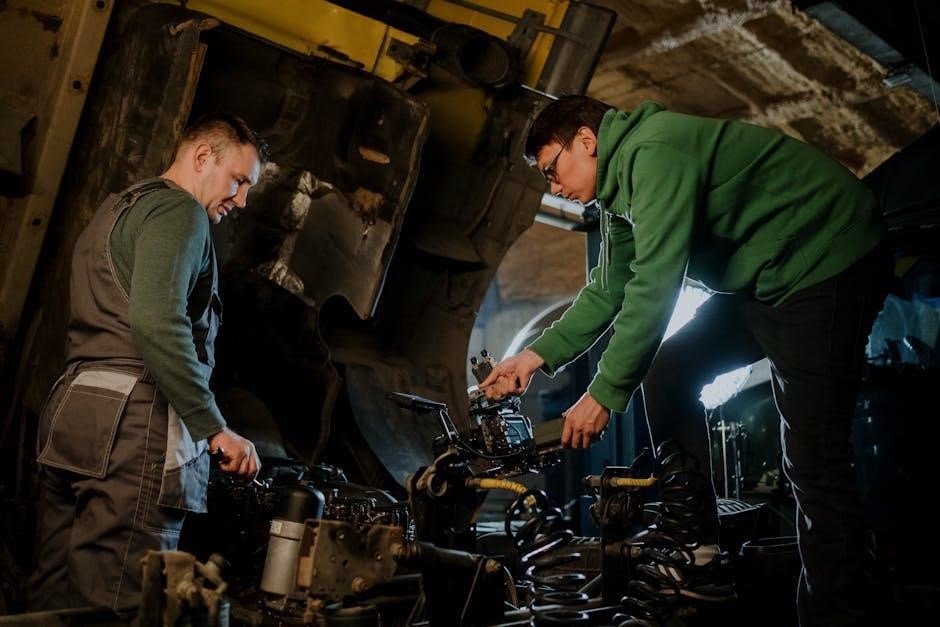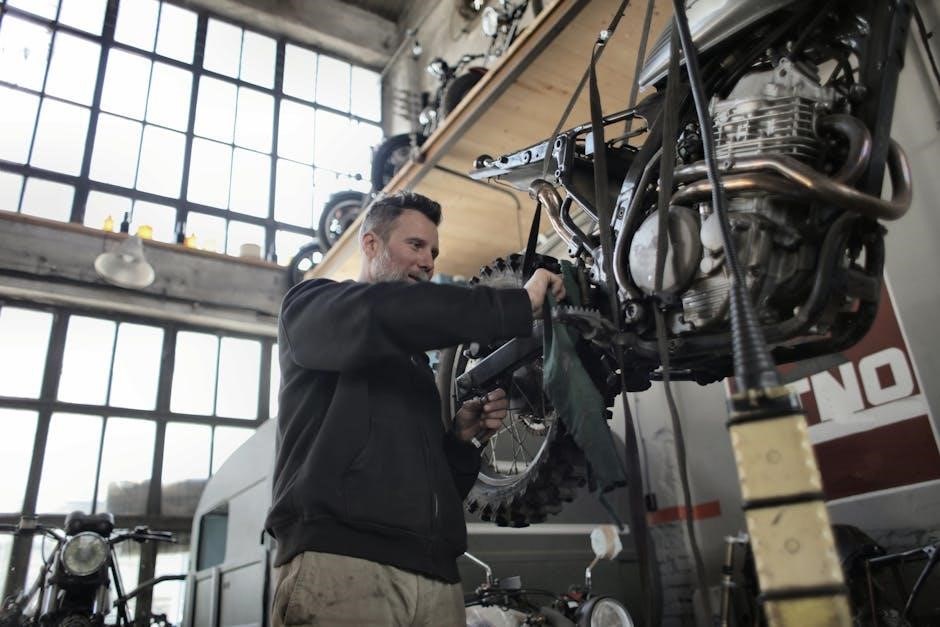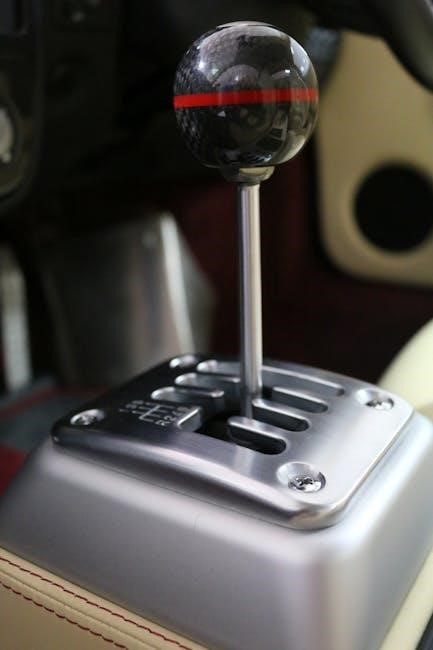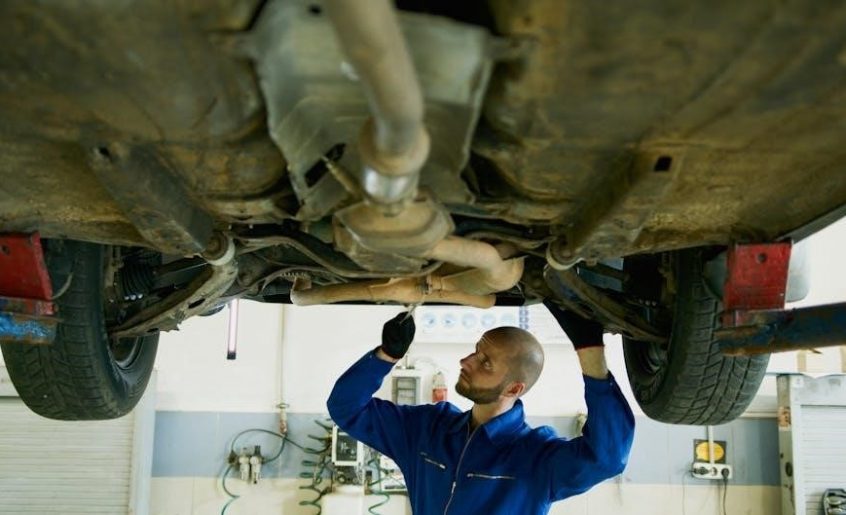What Makes a Car Good for Learning Manual Transmission
A good car for learning manual transmission should have simple mechanics‚ low maintenance costs‚ and a forgiving clutch system. These features reduce stress and allow learners to focus on mastering the basics without worrying about expensive repairs or complex handling.
- Simplicity in Design: A straightforward mechanical setup helps learners understand the process better.
- Low Maintenance Costs: Affordable parts and repairs make it easier to handle minor mistakes during the learning phase.
- Forgiving Transmission: A smooth and patient clutch system minimizes the risk of stalling or damaging the car.
This combination creates an ideal environment for practicing and building confidence in manual driving skills.

1.1 Simplicity in Design and Mechanics
A car with simple design and mechanics is ideal for learning manual transmission. Complex systems can overwhelm new drivers‚ while straightforward engineering makes the learning process smoother. Cars with fewer electronic aids and uncomplicated gearboxes allow learners to focus on mastering clutch and accelerator coordination. Mechanical simplicity reduces the likelihood of confusion and frustration‚ enabling learners to develop muscle memory and confidence. Additionally‚ cars with intuitive controls and minimal distractions provide a stress-free environment for practicing shifting and braking. This simplicity ensures that learners can concentrate on the fundamentals without being hindered by overly complex features.
- Intuitive Controls: Easy-to-use interfaces help learners focus on the driving process.
- Minimal Distractions: A clutter-free design reduces stress during practice.
- Muscle Memory Development: Simple mechanics aid in mastering clutch and accelerator coordination.
Such cars provide an excellent foundation for building essential driving skills.
1.2 Low Cost of Maintenance and Repair
A car with low maintenance and repair costs is essential for learning manual transmission. Learners often make mistakes‚ such as stalling or riding the clutch‚ which can strain the vehicle. Affordable parts and labor reduce financial stress‚ making it easier to practice without worrying about costly repairs. Cars with reliable engines and straightforward mechanical systems are ideal‚ as they minimize unexpected expenses. Additionally‚ models with good fuel efficiency lower the overall cost of practice sessions. A budget-friendly car creates a stress-free environment for mastering manual driving skills.
- Affordable Parts: Reduces financial burden from potential repairs.
- Reliable Engines: Minimizes unexpected maintenance costs.
- Good Fuel Efficiency: Lowers the cost of frequent practice sessions.
This practicality makes such cars perfect for new drivers learning to drive manual.
1.3 Forgiving Transmission and Clutch System
A forgiving transmission and clutch system is crucial for learning manual transmission. Cars with smooth‚ progressive clutch engagement and a patient gearbox allow learners to make mistakes without stalling frequently or causing damage. This reduces frustration and anxiety‚ creating a more enjoyable learning experience. A responsive yet gentle clutch helps new drivers develop a feel for the “biting point” and master smooth shifts. Additionally‚ a forgiving system minimizes the risk of mechanical stress‚ making it ideal for practice. This feature is essential for building confidence and skill in manual driving.
- Smooth Clutch Engagement: Reduces jerky starts and stalls.
- Patient Gearbox: Allows for gradual learning without damage.
- Progressive Feel: Helps learners develop a sense of control.

Key Features to Look for in a Car for Learning Manual
Look for cars with smooth transmissions‚ responsive acceleration‚ and a clear clutch engagement point. These features help learners practice gear shifts and clutch control without frequent stalling.

- Smooth Transmission: Ensures easy gear changes and reduces jerking.
- Responsive Acceleration: Allows for better control during low-speed maneuvers.
- Clear Clutch Engagement: Helps learners feel when the clutch “bites‚” making shifts smoother.
2.1 Smooth and Forgiving Transmission
A smooth and forgiving transmission is essential for learning manual driving. It minimizes jerking and stalling‚ allowing learners to practice gear shifts confidently. Cars with well-designed transmissions‚ such as the Toyota Corolla or Honda Civic‚ offer gradual clutch engagement‚ making it easier to master the balance between accelerator and clutch. This feature reduces anxiety and frustration‚ enabling learners to focus on coordination and control. A forgiving transmission also helps avoid costly repairs from frequent stalls or improper shifting‚ making the learning process more enjoyable and stress-free for new drivers.
2.2 Responsive but Gentle Acceleration
A car with responsive but gentle acceleration is ideal for learning manual transmission. It provides enough power to practice shifting gears smoothly without overwhelming the driver. Cars like the Toyota Corolla or Honda Civic offer balanced engines that respond well to input‚ making it easier to coordinate clutch and accelerator. This responsiveness helps learners master the timing of gear shifts and reduces the likelihood of stalling. Gentle acceleration also allows for better control in low-speed maneuvers‚ such as stopping and starting on inclines‚ which are crucial for building confidence in manual driving skills. This balance is key for a stress-free learning experience.
2.3 Clear “Biting Point” for Clutch Engagement
A clear “biting point” in a car’s clutch system is essential for learning manual transmission. The biting point is the precise moment when the clutch begins to engage with the engine‚ allowing for smooth gear shifts. A well-defined biting point helps learners understand when to release the clutch fully‚ reducing the risk of stalling. Cars with a clear biting point‚ such as the Honda Civic or Volkswagen Golf‚ provide immediate feedback‚ making it easier for new drivers to master the clutch-and-accelerator balance. This clarity allows learners to focus on coordinating their movements and building muscle memory‚ which is critical during the early stages of learning manual driving.

Popular Car Models Recommended for Learning Manual
Popular models like the Toyota Corolla‚ Honda Civic‚ and Volkswagen Golf are ideal for learning manual transmission due to their simplicity‚ reliability‚ and smooth clutch engagement.
3.1 Toyota Corolla (Pre-2010 Models)
The Toyota Corolla‚ particularly pre-2010 models‚ is an excellent choice for learning manual transmission. Known for its reliability and simplicity‚ it offers a smooth clutch system and forgiving transmission‚ making it ideal for beginners. The lightweight design and responsive acceleration allow learners to practice gear shifting and clutch control without unnecessary stress. Additionally‚ the Corolla’s low maintenance costs and availability of affordable parts make it a practical option for those who may occasionally stall or wear down the clutch during the learning process. Its clear “biting point” and easy handling further enhance the learning experience.
- Reliable and Durable: Built to last‚ with minimal complex features.
- Affordable Maintenance: Low-cost repairs and readily available parts.
- Smooth Clutch Engagement: Forgiving for learners‚ reducing frustration.
Overall‚ the Toyota Corolla provides a stress-free environment for mastering manual driving skills‚ making it a top recommendation for new drivers.
3.2 Honda Civic (6th or 7th Generation)
The Honda Civic‚ specifically the 6th and 7th generation models‚ is highly regarded for learning manual transmission due to its intuitive handling and responsive clutch system. These models are known for their reliability‚ making them a popular choice for new drivers. The smooth acceleration and precise gear shifting provide a forgiving experience‚ allowing learners to build confidence. Additionally‚ the Civic’s compact size and lightweight design make it easy to maneuver‚ reducing the stress often associated with learning to drive a manual car. Its reputation for durability and low maintenance further solidifies it as an excellent choice for mastering manual driving skills.
- Responsive Clutch System: Makes it easier to feel and control the “biting point.”
- Intuitive Handling: Lightweight and balanced‚ ideal for practicing techniques.
- Reliable and Durable: Known for long-term performance with proper care.
Overall‚ the Honda Civic offers a seamless and forgiving platform for learners to hone their manual driving abilities.
3.3 Volkswagen Golf (Mk4 or Mk5)
The Volkswagen Golf Mk4 and Mk5 are excellent choices for learning manual transmission due to their forgiving clutch and smooth gear transitions. These models are known for their reliability and durable build quality‚ making them ideal for new drivers. The compact size and responsive handling provide ease of control‚ while the affordable maintenance costs reduce financial stress. The Golf’s balanced weight distribution and clear visibility further enhance the learning experience‚ offering a comfortable and confidence-inspiring platform for mastering manual driving skills.
- Forgiving Clutch System: Allows for smooth engagement and minimizes stalling.
- Compact and Maneuverable: Easy to handle in tight spaces.
- Reliable and Affordable: Low maintenance costs and durable construction.
Overall‚ the Volkswagen Golf Mk4 and Mk5 strike a perfect balance of practicality and performance for learners.

Benefits of Learning on a Manual Car
Learning on a manual car enhances driving control‚ reduces distractions‚ and improves overall driving awareness and skill. It also fosters better connection with the vehicle.
- Improved Control: Manual driving requires active engagement‚ enhancing vehicle command.
- Reduced Distraction: Mastery of gears and clutch minimizes driving distractions.
- Enhanced Skills: Develops better situational awareness and driving precision.
These benefits contribute to becoming a more confident and capable driver.
4.1 Improved Control Over the Vehicle
Learning on a manual car grants enhanced control‚ as drivers must actively manage gears and clutch‚ leading to better command of speed and acceleration.
- Active Engagement: Manual shifting keeps drivers focused‚ reducing the likelihood of distractions.
- Precise Acceleration: Control over torque and speed allows for smoother maneuvering‚ especially in challenging conditions.
- Better Connection: The necessity to coordinate clutch and accelerator creates a stronger bond between the driver and the vehicle.
This heightened control fosters confidence and proficiency‚ making drivers more adept at handling various road scenarios effectively.
4.2 Reduced Risk of Distraction While Driving
Learning to drive a manual car reduces distractions by requiring active engagement with the vehicle. The need to coordinate clutch‚ accelerator‚ and gears keeps the driver focused on the road.
- Active Participation: Manual driving demands constant attention‚ minimizing the likelihood of distractions like using a phone or adjusting settings.
- Heightened Awareness: The process of shifting gears encourages drivers to anticipate traffic and road conditions‚ fostering better situational awareness.
- Improved Concentration: The mechanical interaction with the car helps drivers stay mentally engaged‚ reducing the risk of mind-wandering or complacency.
This engagement leads to safer driving habits and a lower likelihood of accidents caused by distractions.
4.3 Enhanced Driving Skills and Awareness
Learning to drive a manual car enhances overall driving skills and situational awareness. The process of shifting gears and controlling speed requires a deeper connection with the vehicle and its surroundings.
- Better Control: Manual driving demands precise pedal and gear coordination‚ improving coordination and reaction times.
- Greater Awareness: Drivers must anticipate road conditions‚ traffic flow‚ and gear shifts‚ fostering heightened observational skills.
- Improved Mechanics Understanding: Familiarity with clutch and transmission operation gives drivers a better grasp of how their car functions.
These skills translate to safer‚ more confident driving‚ regardless of the vehicle being driven.
Tips for Choosing the Right Car to Learn Manual
When selecting a car to learn manual‚ prioritize reliability‚ simplicity‚ and a smooth transmission. These factors make the learning process easier and less intimidating.
5.1 Consider the Car’s Weight and Size
Opt for a lightweight car with compact dimensions for easier handling. Lighter vehicles are more responsive and simpler to maneuver‚ reducing fatigue during practice. Smaller cars also offer better visibility and are less intimidating for new drivers. Avoid heavy or oversized vehicles‚ as they can be challenging to control during stalling or slow-speed maneuvers. Compact sedans or hatchbacks‚ such as the Toyota Corolla or Honda Civic‚ are ideal due to their balanced weight distribution and manageable size‚ making them perfect for mastering manual transmission skills.
-
5.2 Avoid High-Performance or Sports Cars
High-performance or sports cars are not ideal for learning manual transmission due to their powerful engines and intricate mechanics. These vehicles often have a stiffer clutch and faster acceleration‚ making it harder for learners to control. Additionally‚ they are typically more expensive to maintain and repair‚ increasing the cost of potential mistakes. The intense driving dynamics of sports cars can also be intimidating for new drivers. Opting for a standard sedan or hatchback is a more practical and forgiving choice for mastering manual transmission skills.
-
5.3 Look for Cars with a Reputable Reliability Record
Choosing a car with a strong reliability record is crucial for learning manual transmission. A reliable vehicle minimizes breakdowns and reduces stress‚ allowing learners to focus on mastering the clutch and gears. Cars with a history of dependable performance are also more cost-effective in the long run‚ as they require fewer repairs and have lower maintenance costs. Look for models known for durability‚ such as the Toyota Corolla or Honda Civic‚ which are often praised for their consistent performance and low ownership expenses. A reliable car ensures a smoother and more enjoyable learning experience.
- Reliable cars reduce stress and anxiety/
- Lower maintenance and repair costs/
- Durable models are ideal for learners/
-
